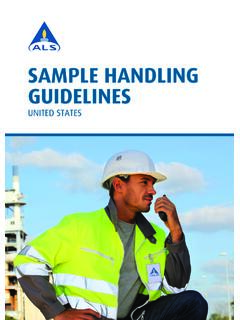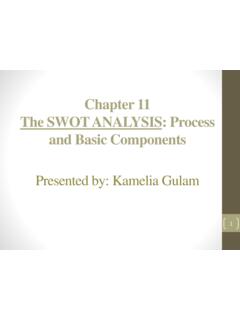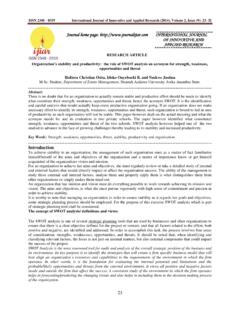Transcription of Risk Management Policy - ALS
1 Risk Management Policy Right Solutions Right Partner Risk Management Policy Statement ALS recognises that the effective Management of risks is a fundamental component of good corporate governance and is vital for the company's continued growth and success. ALS is committed to enterprise-wide risk Management to ensure its corporate governance responsibilities are met and its strategic goals are realised. Enterprise-risk Management enables ALS to identify and manage risks to: Create and sustain a safe and healthy work environment. Improve business performance by optimising growth opportunities. Remain innovative and establish competitive advantage. Anticipate and communicate uncertainties. Reduce operational losses and surprises. Protect the company's reputation and brand. The objectives of the ALS Limited Risk Management Policy and Framework are to: Provide a consistent and systematic approach to identify, analyse, evaluate, treat, monitor and report on the portfolio of risks.
2 Ensure Management is presented with the best available information on which to base its decisions. Ensure decisions made are aligned with the company's appetite for risk and are undertaken within approved risk tolerances and are executed with sufficient independent oversight. Provide assurance through internal audit activities that internal controls are in place and are operating effectively and efficiently. Application This Policy applies to all ALS businesses. Resources ALS will provide the necessary resources and support mechanisms to ensure its commitment toward risk Management is achieved. Implementation Each ALS business is responsible for implementing the requirements of this Policy in consultation with their employees. Cooperation is needed, and expected, from all employees. The effective Management of risk is vital to the continued growth and success of our Group. Raj Naran Chief Executive Officer CAR-GL-GRP-POL-007 Version 11 Revision Date 30/03/2021 Page 2 of 13.
3 Right Solutions Right Partner Introduction This Risk Management Policy sets out the risk Management strategy and minimum requirements for the Management of risk within the Group. This Policy is to be applied to the Management of risks that arise in relation to the Group conducting its business. ALS's strategy for the Management of risk substantially follows the guidelines of ISO 31000:2018 - Risk Management - Guidelines. Definition of Risk ALS defines risk as either a threat or an opportunity. A risk in the form of a threat is defined as the chance of something happening that will negatively impact on the company's ability to meets it objectives. A risk in the form of an opportunity is defined as the chance of something happening that will enhance, or positively impact on, the company's ability to meets its objectives. Both threats and opportunities are measured in terms of consequences and likelihood. Risk Management Framework ALS has an established Risk Management Framework ( the Framework ) to support its commitment to effective risk Management .
4 One of the primary objectives of the Framework is to provide guidance on how to consistently and comprehensively apply risk Management in order to optimise the Management of risk. Additional objectives of the Framework include: recognising that successful risk Management is the responsibility of all employees. optimising financial growth opportunities. reducing the likelihood of deficient or ineffective strategic and business planning through embedding risk evaluation in all strategic and business planning. reducing the likelihood of failures and cost overruns by applying effective risk assessment and Management in the planning and implementation of projects, and business initiatives and activities. reducing the likelihood, and potential impacts including financial cost to the company of fraud, insurance claims and complaints. encouraging the identification and reporting of actual or potential risk incidents. protecting and promoting the company's public image and reputation as a professional, responsible and ethical organisation.
5 Risk Management Process The Framework includes the application of the company's interpretation of the risk Management process contained in ISO 31000:2018 Risk Management - Guidelines, as it is set out below. 1. Establish the Context Before formally assessing risks, each Business Stream should ensure they consider and detail the context in relation to their specific business including: Governance/ Management structure Services provided Physical environment (property and location details). Service dependencies (internal & external). Competition CAR-GL-GRP-POL-007 Version 11 Revision Date 30/03/2021 Page 3 of 13. Right Solutions Right Partner Establishing the context also requires consideration of ALS's agreed risk appetite and tolerances in relation to: 1. Reputation;. 2. Finance / Commercial;. 3. People and Culture;. 4. Governance;. 5. Information and Systems Management ;. 6. Operational; and 7. Environment (including economic, environmental, and social sustainability).
6 Refer to the ALS Risk Appetite and Tolerance Policy for more information. 2. Risk Assessment Risk assessment is the overall process of risk identification, risk analysis and risk evaluation. The process aims to highlight the material risks to, or in, the business to ensure that resource allocation is directed towards mitigating controls around material risks that present as threats; and resource allocation is directed towards actions to optimise material risks presenting as opportunities eventuating. (a) Risk Identification The risk identification process involves identifying and documenting risks across all areas of the business. Risks can be identified in a multitude of ways through day-to-day activities, proactively through formal risk Management workshops, or reactively as a result of certain events occurring. External, strategic, financial and operational risks are incorporated in the risk identification step, with such risks being identified through a systematic process as per the table below: Risk Identification Examples Group Strategic Workshops Business strategic planning reviews Material Business Risk workshops incorporating techniques such as strengths, weaknesses, opportunities, threats' (SWOT) analysis.
7 Brainstorming; analysis of systems or scenarios Operational Activities Monthly team meetings Business and operations managers forums Capital expenditure risk assessments Routine data collection and business data analysis Assessment against Financial reviews and external audits Standards Six monthly compliance process reviewing compliance against company Policy , key risk controls, and legal compliance Internal audit and peer reviews Third Party accreditation reviews (ISO, NATA, TIC Council). Corporate Compliance and Risk audits Health Safety and Environment (HSE) and Injury Management (IM). inspections/audits Incident or Event Internal incident or complaint reporting via the ALS Compliance Logging Portal incorporating health, safety, environment and property incidents ALS Integrity + Compliance Helpline Exception Reporting Monthly exception reporting incorporating legal, information technology, employment practices, insurance, trade practices, environmental, HSE, tax and corporations law risks.
8 CAR-GL-GRP-POL-007 Version 11 Revision Date 30/03/2021 Page 4 of 13. Right Solutions Right Partner (b) Risk Analysis The risk analysis step involves the calculation of the risk based on the consequence of the event and likelihood of the identified event happening. For the majority of risks that take the form of incidents or non compliances, risk analysis is built into reporting requirements ALS Group standard incident report forms require investigation and corrective actions. A risk assessment matrix has been developed to be used across ALS for Group-wide risks. Business Streams may adopt more specific Business Stream operational risk matrices, provided those matrices are not misaligned with the matrix used for Group- wide risks.. Consequences are grouped under the areas of Financial, Legal, Reputation, HSE, and Operational. An ALS tailored five by five consequence and likelihood risk matrix is used to apply a rating to each identified risk.
9 Table 1 below provides an example of a consequence matrix; and Table 2 provides an example of a risk matrix. Risk velocity adds a third dimension to the risk analysis process. Velocity considers the following factors associated with a risk: Speed of onset requires the consideration of how quickly a risk might occur and how much warning will the organisation have to prepare. Speed of impact relates to how quickly and in what manner an organisation will be impacted by the onset. CAR-GL-GRP-POL-007 Version 11 Revision Date 30/03/2021 Page 5 of 13. Right Solutions Right Partner Speed of reaction relates to an organisations ability to see the risk coming and agility to react in a timely manner. Table 3 provides examples of a Likelihood Guide and a Velocity of Risk Scale. Chart 1 illustrates the velocity of risk from a threat perspective of Group-wide risks with an extreme, very high or high residual risk rating. This bubble chart helps prioritise each risk a risk with a high speed of onset and or impact may require a fast speed of reaction to implement the required risk treatments.
10 CAR-GL-GRP-POL-007 Version 11 Revision Date 30/03/2021 Page 6 of 13. Right Solutions Right Partner To ensure a consistent approach is taken for the assessment of material business risks, ALS has implemented a standard register to record all identified Group-wide risks. Risk Management workshops are held by the Corporate Compliance and Risk team with senior Management teams from each Business Stream to identify and record material business risks. The outcomes of the risk workshops are recorded on the ALS Risk Register. The Register is maintained and managed by the Chief Risk Officer. It captures the inherent, residual and target risk ratings and is a living document'. It includes details of risk treatments in place and further risk treatments to be implemented, if applicable. An example of the template of the ALS Risk Register appears below. (c) Risk Evaluation The risk rating calculated from the Risk Array Matrix establishes the priority of the identified risk.










